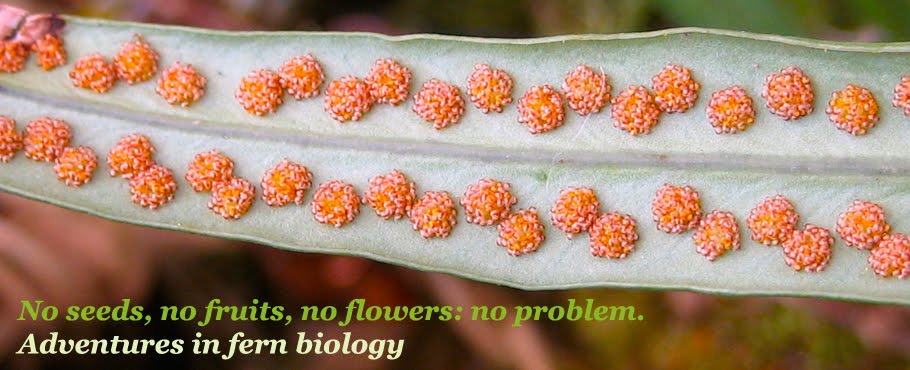However, we came across an unfortunate surprise once we found the valley with D. celsa. The population of this fern, which had been thriving the last time I visited four or so years ago, has been drastically reduced. We saw very many fewer adult individuals of D. celsa than last time, and almost no evidence of new recruitment in the form of young sporophytes. Tom and I are both at a loss as to what may have caused this; climate change and wild hogs seem like the two most likely suspects. The remaining D. celsa individuals are still lush and beautiful, but I worry now that the population may be on its way out.
Friday, June 19, 2015
Dryopteris celsa at Panther Creek
On the way back to Gainesville from western Virginia (I drove), I stopped to visit an old friend and colleague, Tom Goforth of Crowdog Native Ferns and Gardens in Pickens, South Carolina. I spent a few lovely days with Tom to catch up, and we visited one of my favorite sites from my PhD studies, a place Tom has known of and visited for years: Panther Creek in northeastern Georgia. The highlight of this spot, for me, is Dryopteris celsa. This was the first place I ever saw this fern, one of the allopolyploids in the North American Dryopteris complex. Getting to the populations of D. celsa at this site involves wading across a rive and choosing the right valley to walk up on the other side, amid dense forest and a thriving understory. It's a really beautiful place:
Monday, June 15, 2015
Virginia ferns, part III: Vittaria appalachiana
The highlight of our trip to Virginia (posts I and II) was finding Vittaria appalachiana in a perfect sandstone habitat at the end of a trail near Mountain Lake Biological Station. The trail was called Bear Cliffs trail, and it terminates in some craggy shallow gorges that are full of ferns and other vegetation. Our group included several researchers who have worked extensively on fern gametophytes and several gametophyte-only species - these are ferns that never make sporophytes (the big, green, leafy things that we think of when we think about ferns). A classic example of this type of life history in ferns is Vittaria appalachiana, also known as the Appalachian gametophyte, which occurs in sheltered sandstone rockhouses throughout the Appalachian mountains and plateau region. After a thorough hunt, we were able to turn up some V. appalachiana tucked back in one of the sandstone shelters!
 |
| Typical sheltered habitat for V. appalachiana |
 |
| The dark crevices are where these ferns like to live |
 |
| Joel Nitta, a grad student at Harvard, after gametophytes! |
 |
| The product of a successful search - a tweezer-ful of Appalachian gametophytes |
Wednesday, June 10, 2015
Virginia ferns, part II: Dryopteris
Continuing the posts about our trip to Virginia with some photos of Dryopteris, the wood ferns! Most of these are of D. campyloptera, the mountain woodfern. It is an allopolyploid of D. expansa and D. intermedia, and has an interesting distribution, restricted to higher elevations and/or more northern latitudes in the eastern U.S.
 |
| D. campyloptera |
 |
| Typical D. campyloptera habitat |
 |
| D. campyloptera |
 |
| More foggy mountain-top habitat! |
 |
| D. marginalis |
 |
| D. marginalis |
 |
| D. marginalis |
Monday, June 8, 2015
Virginia ferns, part I: Asplenium
Last week there was a once-in-a-decade fern conference held at the Smithsonian Institution in Washington, D.C. Every ten years or so the fern community gets together to hold such a meeting, and people come from around the world to hear about what's new and exciting in fern biology. Next Generation Pteridology was the name of this meeting and it was a great success and a lot of fun. After the conference, I headed to the field with some old fern friends to do a bit of exploring in western Virginia. We were particularly interested in finding populations of Asplenium and Dryopteris species, and we were successful. I'll post the pictures of Dryopteris in part II, but here are three species of Aspleniums and a few other botanical highlights.
 |
| Asplenium platyneuron |
 |
| Asplenium trichomanes |
 |
| Two Aspleniums |
 |
| Asplenium rhizophyllum, the walking fern |
 |
| Athyrium filix-femina, lady fern |
 |
| Pellaea glabra |
 |
| Some gratuitous lichens! |
Subscribe to:
Comments (Atom)




